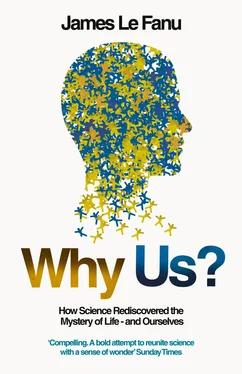Meanwhile, the human brain toowas about to reveal its secrets. Its physical appearance is quite as familiar as the Double Helix. But the specialisation of those separate parts for seeing, hearing, movement and so on is in a sense deceptive, concealing the crucial question of how their electrical firing translates the sights and sounds of the external world, or summons those evocative childhood memories from the distant past. How does this mere three pounds of soft grey matter within the skull contain the experience of a lifetime?
Here again, a series of technical innovations, paralleling those of the New Genetics, would permit scientists for the first time to scrutinise the brain ‘in action’. In 1973 the British physicist Godfrey Hounsfield invented the Computed Tomography (CT) scanner, revealing the brain’s internal structure with an almost haunting clarity, revolutionising the diagnosis of strokes and tumours and other forms of mischief. Soon after, the further technical development of Positron Emission Tomography (PET) scanning would transform the CT scanner’s static images or ‘snapshots’ of the brain into ‘moving pictures’.
Put simply, this is how it works. All of life requires oxygen to drive the chemical reactions in its cells. This oxygen is extracted from the air, inspired in the lungs and transported by blood cells to the tissues. When, for example, we start talking, the firing of the neurons in the language centre of the brain massively increases their demand for oxygen, which can only be met by increasing the bloodflow to that area. The PET scanner detects that increase in bloodflow, converting it into multi-coloured images that pick out the ‘hotspots’ of activity. Now, for the first time, the internal workings of the brain induced by smelling a rose or listening to a violin sonata could be observed as they happened. Or (as here) picking out rhyming words:
A woman sits quietly waiting for the experiment to begin – her head ensconced in a donut-shaped device, a PET scanning camera. Thirty-one rings of radiation detectors make up the donut, which will scan thirty-one images simultaneously in parallel horizontal lines. She is next injected with a radioactive isotope [of oxygen] and begins to perform the task … The words are presented one above the other on a television monitor. If they rhyme, she taps a response key. Radiation counters estimate how hard the brain region is working … and are transformed into images where higher counts are represented by brighter colours [thus] this colour map of her brain reveals all the regions acting while she is judging the paired words.
The details will come later, but the PET scanner would create the discipline of modern neuroscience, attracting thousands of young scientists keen to investigate this previously unexplored territory. Recognising the possibilities of the new techniques, the United States Congress in 1989 designated the next ten years as ‘the Decade of the Brain’ in anticipation of the many important new discoveries that would deliver ‘precise and effective means of predicting, modifying and controlling individual behaviour’. ‘The question is not whether the neural machinery [of the brain] will be understood,’ observed Professor of Neurology Antonio Damasio, writing in the journal Scientific American, ‘but when.’
Throughout the 1990s, both the Human Genome Project and the Decade of the Brain would generate an enormous sense of optimism, rounding off the already prodigious scientific achievements of the previous fifty years. And sure enough, the completion of both projects on the cusp of the new millennium would prove momentous events.
The completion of the first draft of the Human Genome Projectin June 2000 was considered sufficiently important to warrant a press conference in the presidential office of the White House. ‘Nearly two centuries ago in this room, on this floor, Thomas Jefferson spread out a magnificent map … the product of a courageous expedition across the American frontier all the way to the Pacific,’ President Bill Clinton declared. ‘But today the world is joining us here to behold a map of even greater significance. We are here to celebrate the completion of the first survey of the entire human genome. Without a doubt this is the most important, most wondrous map ever produced by mankind.’
The following year, in February 2001, the two most prestigious science journals, Nature and Science, each published a complete version of that ‘most wondrous map ever produced by mankind’ as a large, multi-coloured poster displaying the full complement of (as it would turn out) twenty-five thousand human genes. It was, as Science observed, ‘an awe-inspiring sight’. Indeed, it was awesome twice over. Back in the 1950s, when Francis Crick and James Watson were working out the structure of the Double Helix, they had no detailed knowledge of a single gene, what it is or what it does. Now, thanks to the techniques of the New Genetics, those involved in the Genome Project had, in less than a decade, successfully culled from those three billion ‘coloured discs’ strung out along its intertwining strands the hard currency of each of the twenty-six thousand genes that determine who we are.
The Human Genome map, like Thomas Jefferson’s map of the United States, portrays the major features of that genetic landscape with astonishing precision. While it had taken the best part of seven years to find the defective gene responsible for the lung disorder cystic fibrosis, now anyone could locate it from that multi-coloured poster in as many seconds. Here too at a glance you can pick out the gene for the hormone insulin, which controls the level of sugar in the blood, or the haemoglobin molecule that transports oxygen to the tissues. To be sure, the functions of many thousands of those genes remained obscure, but now, knowing their precise location and the sequence of which they are composed, it would be only a matter of time before they too would be known. It was a defining moment. ‘Today will be recorded as one of the most significant dates in history,’ insisted one of the major architects of the Genome Project, Dr Michael Dexter of the Wellcome Trust in Britain. ‘Just as Copernicus changed our understanding of the solar system and man’s place within it, so knowledge of the human genome will change how we see ourselves and our relationship to others.’
The goals of the Decade of the Brainwere necessarily more open-ended, but still the PET scanner, and the yet more sophisticated brain imaging techniques that followed in its wake, had more than fulfilled their promise, allowing scientists to draw another exquisitely detailed map locating the full range of mental abilities to specific parts of the brain. There were many surprises along the way, not least how the brain fragmented the simplest of tasks into a myriad of different components. It had long been supposed, for instance, that the visual cortex at the back of the brain acted as a sort of photographic plate, capturing an image of the external world as seen through the eye. But now it turned out that the brain ‘created’ that image from the interaction of thirty or more separate maps within the visual cortex, each dedicated to one or other aspect of the visual image, the shapes, colour, movement of the world ‘out there’. ‘As surely as the old systemwas rooted in the concept of an image of the visual world received and analysed by the cortex,’ observes Semir Zeki, Professor of Neurobiology at the University of London, ‘the present one is rooted in the belief that an image of the visual world is actively constructed by the cerebral cortex.’
Steven Pinker, Professor of Brain and Cognitive Science at the Massachusetts Institute of Technology, could explain to the readers of Time magazine in April 2000 (the close of the Decade of the Brain) how neuroscientists armed with their new techniques had investigated ‘every facet of mindfrom mental images to moral sense, from mundane memories to acts of genius’, concluding, ‘I have little reason to doubt that we will crack the mystery of how brain events correlate with experience.’
Читать дальше












